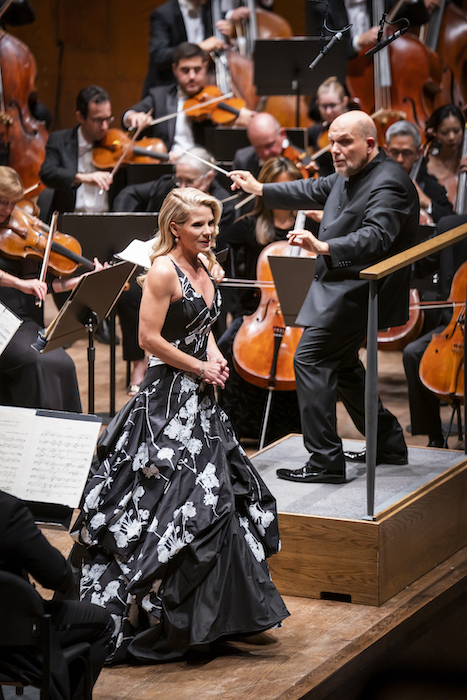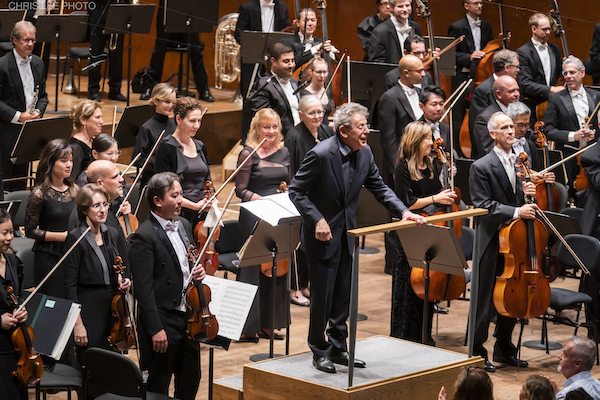Kaleidoscopic Glass premiere lifts a mixed Philharmonic opener

Opening night isn’t usually the time when a symphony orchestra takes risks, but risk was everywhere at Wednesday’s season opener of the New York Philharmonic, conducted by music director Jaap van Zweden.
Of course, programming a world premiere by Philip Glass isn’t the risk it used to be, when the composer was flummoxing audiences with his music of raw repetition. These days, a new work by the old master is a distinction, even a draw.
But a King Lear Overture? Over the centuries, Shakespeare’s wintry, nihilistic tragedy has defied nearly all attempts to set it to music. Maybe it would take an octogenarian composer to find the handle on it.
And Kelli O’Hara singing Barber’s Knoxville: Summer of 1915? The Broadway and television star was a draw for sure, and she had some Met successes (in The Merry Widow and the comic role of Despina) on her résumé. Billed in the program not as “soprano” but as “vocalist,” how would she fare in a soaring part associated with great American singers from Steber and Price to Upshaw and Fleming?
But perhaps the greatest risk of all was going onstage as poorly prepared as the Philharmonic sounded for much of Wednesday night. It wasn’t until the last movement of the last work on the program—the shattering “Death of Tybalt” from Prokofiev’s Romeo and Juliet—that the orchestra truly hit its stride and sounded like the world-class ensemble it is capable of being.
The general order of the evening was the kind of “almost” ensemble—woodwinds a little out of sync and out of tune, strings unfocused—one associates with a not-bad regional orchestra, a member not of the Big Five but of the Pretty Big Hundred-and-Five.
It wasn’t for lack of effort by van Zweden on the podium. He seemed to be making his beat and his intentions quite clear, even bouncing on his knees in an effort to coax a waltz lilt out of the orchestra in the early pages of the Barber. But rhythmic life was in short supply nearly all evening, as the players studiously executed their parts.
Glass’s new work was marvelously turbulent, even kaleidoscopic. The onetime minimalist became a maximalist, throwing out new ideas at the rate of one every few seconds to convey the terrible agitation of the play’s action and the protagonist’s mind. The composer’s characteristic cycling harmonies could barely get started before they struck an obstacle and shattered or diverted. The orchestra’s sections constantly formed and re-formed massive blocks of sound.

By definition, a world premiere has no other performances to compare it to. So one could only wonder what Glass’s piece might sound like with clearer definition of those orchestral blocks, and sharper “glass pieces” in the kaleidoscope.
The King Lear Overture has no opera to go with it—yet. (In a program note, Glass hinted tantalizingly at the possibility of one, based on the material in this piece.) But as a ten-minute orchestral piece, it staged a brave assault on Shakespeare’s impregnable play and earned enthusiastic applause, which rose to a roar when van Zweden ushered the 82-year-old composer onstage for a bow.
In the annals of hard acts to follow, Glass’s Philharmonic triumph would be right up there, especially when the next item is a Broadway entertainer taking a crack at one of the most elusive yet taxing soprano solos in the repertoire. But singer O’Hara gave a good account of herself, in a slender, somewhat piercing voice that took the part’s sudden high flights with apparent ease.
It was surprising that this musical-theater artist didn’t avail herself of some of the opportunities for bluesy slides and speech-singing that Barber put in the score, and that other singers (Price in particular) have deftly exploited.
The piece’s nostalgia for a small-town, prewar America is not of the Technicolor Music Man, insurance-ad variety, but something much more nuanced and indistinct, as real memories are. In James Agee’s poetic text, lantern slides of porch swings and backyard stargazing dissolve into enigmatic metaphors and spiritual yearning, and Barber’s often-wispy score calls for fine shadings of tone color from orchestra and singer alike. Perhaps in an effort to sound “classical,” O’Hara seemed to abandon her theatrical strengths for a singing style in which she had less to offer.
There were times when Barber’s elusive muse seemed to elude van Zweden and his musicians entirely, and indistinct became incoherent. There is a kind of rigor of tuning and ensemble that is needed even for Pelléas et Mélisande, never mind Samuel Barber. But on the whole, singer and orchestra gave a solid representation of the piece, warmly welcomed by the audience.
As Prokofiev said when considering giving his Romeo and Juliet ballet a happy ending, “The dead don’t dance.” In Wednesday’s performance, his music didn’t either. Until near the end, a kind of motoric accuracy was all the firmly seated players could manage, and that not all the time.
Conductor van Zweden made his own selections from the composer’s two orchestral suites, a slight rearrangement that left many of the nine movements in their original suite order and ended as the first suite does, with the spectacular “Death of Tybalt.” This finale, with its furious string scales and hammer blows on what sounded like Thor’s anvil, was as crisply executed and rhythmically alive as the previous movements were lax and casual.
And so perhaps the proper title for this season-opening concert was not King Lear or Romeo and Juliet, but All’s Well That Ends Well.
The program will be repeated 7:30 p.m. Thursday and 8 p.m. Friday and Saturday. nyphil.org; 212-875-5656.